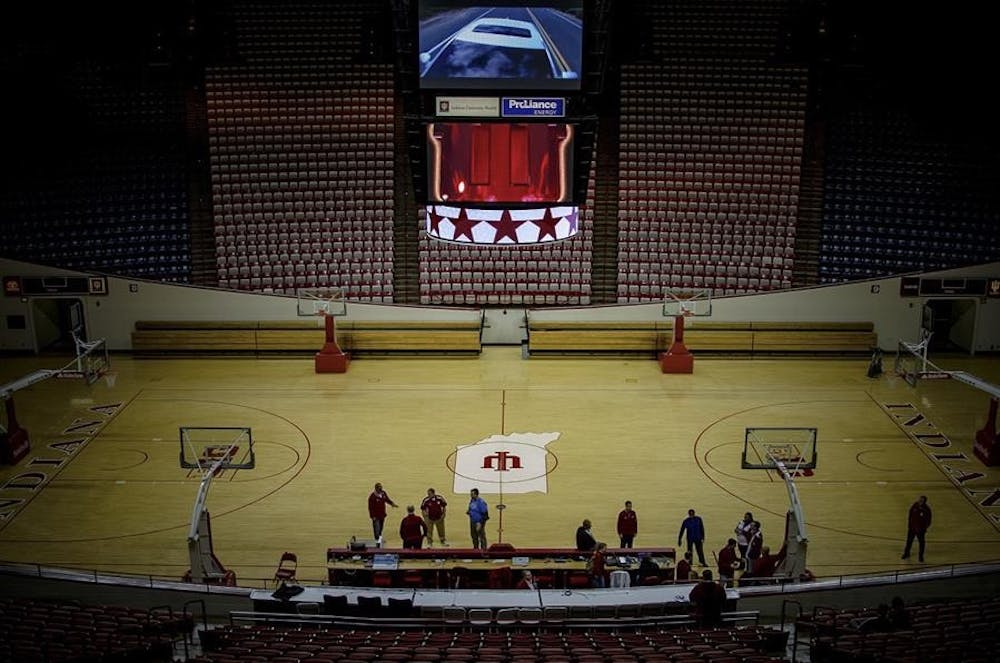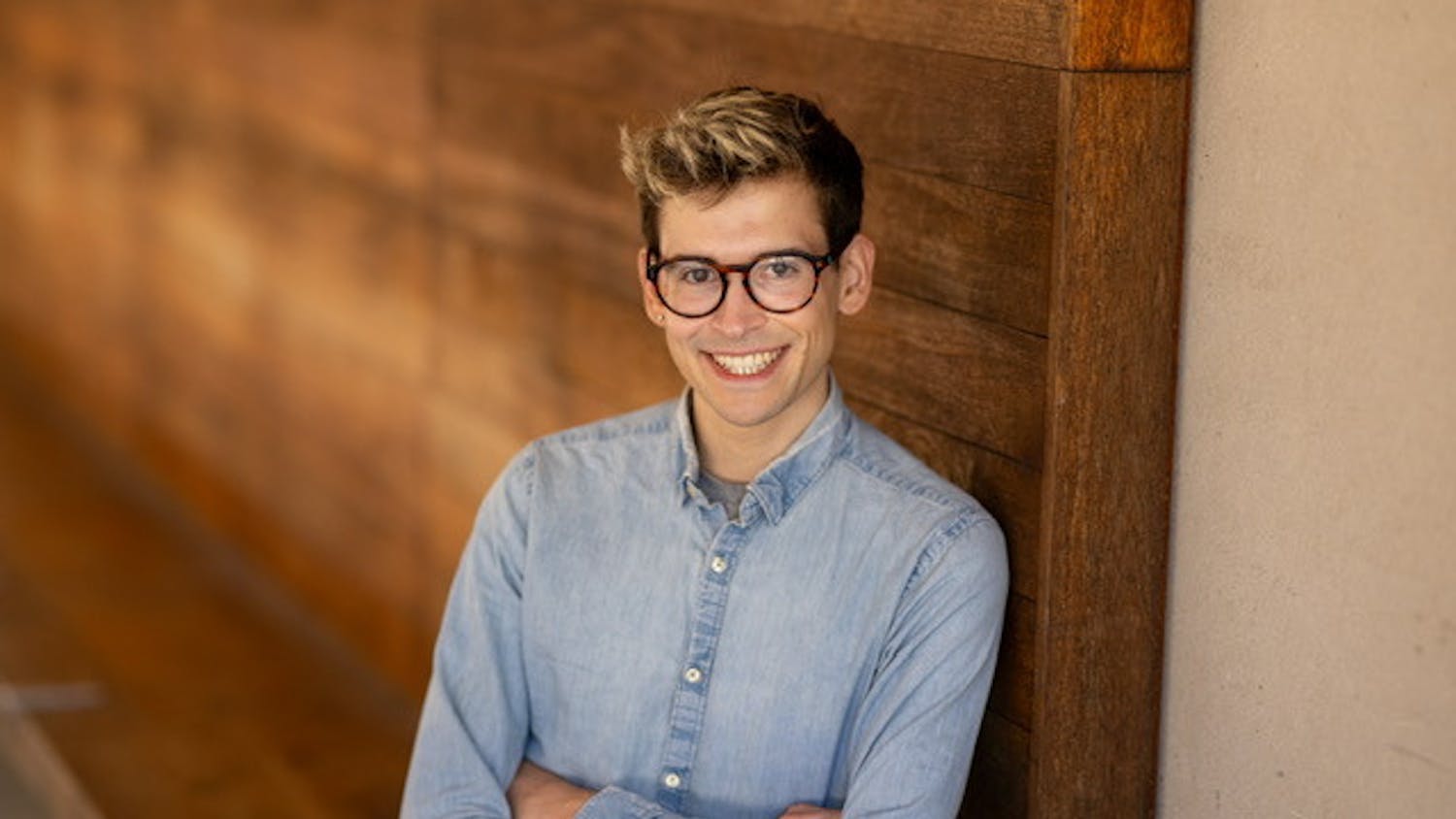Assembly Hall, constructed in 1968, is the hallowed home of the IU men’s and women’s basketball teams. It accommodates 17,472 fans and its 7,800-seat student section is one of the country’s largest. Assembly Hall is most often associated with the five crimson men’s basketball national championship banners that hang from its rafters, not the trash left behind each game by the thousands of fans.
Assembly Hall’s waste management system will undergo a period of assessment and improvement in the offseason in order to be even more effective next year.
Heather Reynolds, an IU associate professor of biology, organized a service-learning project for her HUBI-B 300 Human Dilemmas course.
She contacted Mark Milby, a No Waste Program coordinator at the IU Office of Sustainability, when she needed help setting up a waste audit.
“I think specifically we knew we wanted to do one of Assembly Hall because it was basketball season,” he said. “I’ve probably done about a dozen of them now over the last four or five years and I’ve definitely learned how to make them statistically rigorous. I know it may sound silly but it’s essentially glorified digging through the trash.”
Milby and Erik Schneider, the greening the athletics department intern at the Office of Sustainability, teamed up to carry out the waste audit of Assembly Hall.
Based on the inefficiencies of Assembly Hall’s waste bins, the waste audit team of Schneider, Milby and three undergraduate students created an experiment that utilized Assembly Hall’s symmetry. The arena is identical on either side of Branch McCracken Court, with
the only difference being the fans themselves.
“It was actually a really nice situation to run an experiment because Assembly Hall is kind of symmetrical,” Schneider said. “It allows two different environments to be pretty much the same and it allowed us to test a variable that way. The variable was this new recycling bin.”
Milby said there was good chemistry between he and Schneider.
“It was just a good compromise because he’s in the know about athletics. He’s been working with all of those people and has established good contact and rapport with them,” Milby said. “I’ve done plenty of waste audits in the past, designed them and carried them out.”
Schneider said that by observing the current trash and recycling systems at Assembly Hall, he thought there was room for improvement.
“Hearing about different things about recycling and trash kind of made me think that there was a possibility to try out a new system,” he said.
Bob Gilmore, the custodial shift supervisor of the IU Department of Intercollegiate Athletics, said that Coca-Cola™ recycling bins create problems for properly managing waste at Assembly Hall.
“When they stick a cup in one of these Coke bins and it clogs the lid, the people who are trying to put recycling in can’t get it in there,” Gilmore said. “You have to take the lid off and push it back out to get it out. People care about it but they’re not going to go the extra mile and they’re sure not going to lift a trash can lid to fix it.”
On one side of Assembly Hall, there were six Coca-Cola™ bins that represented the control group. On the opposite side, there were six of the standard blue recycling bins. Three had holes designed for cups and three had the entire faceplate removed to allow for larger items to be recycled.
Schneider also added a second variable by creating signs that instructed fans in which bin to throw their waste. Schneider made signs with prompts for both types of waste, which included pictures and labels for waste items from the concession stands as well as arrows pointing to the correct bin. The signs were placed above only the blue recycling bins and the trashcans that were paired with them.
Schneider said that the goal of the waste audits, with their control and experimental groups, was to examine contamination. He defined contamination as recyclable items in the trash or trash in recycling bins.
Schneider said that it was important for the waste audits to provide a representative sample of the waste management for all of Assembly Hall.
“There is a main upper level with a series of concessions and we were mostly looking there but we also wanted to get some of the items from the seats, some of the items from the ground floor concessions, the court level, and some of the items from the lobby too,” he said.
Schneider, Milby and the undergraduate students collected the bags after three IU men’s basketball games and took them to the Office of Sustainability house on 10th Street.
“We set up a document that had all of the items that we expected to find and then we tallied what we found,” Schneider said. “One person would go through the recycling and trash and basically count what they found.”
He said that the group then weighed the trash and recycling in each bag. They entered the data into Excel spreadsheets and analyzed the results.
“Basically we found what we expected and hoped to find in that the blue bins were more effective in capturing recycling than the Coca-Cola™ bins,” Schneider said. “The circular openings tended to collect a little bit more as well and they also had less contamination because it kind of prompts you to not throw trash in there.”
After analyzing the data, Schneider discovered several specific statistics. Blue recycling bins with circular openings captured more than five bottles and more than six cups above those captured in the Coca-Cola™ recycling bins, on average. Also, the waste audit team did not find a single bottle in a trashcan that was paired with a blue recycling bin with a circular opening. Additionally, the blue recycling bins with rectangular openings captured an average of more than 60 recyclable paper containers.
The most extreme statistic that Schneider calculated is that the trash bins that were not paired with recycling bins had an average contamination rate of 166 percentby weight, which meant that more than two-thirds of the contents could have been recycled.
Although, Schneider said that the use of two variables, the new recycling bin design and the waste management signs, in the waste audit experiment, make it difficult to determine which factor had a stronger influence on the amounts of waste in the bins.
“One way it kind of makes it difficult to tease out which factor was more important in capturing recycling,” he said. “We treat them as a combined effect of the posters plus this new type of bin.”
Schneider came away from the waste audits with three recommendations to improve Assembly Hall’s waste management system: if available, replace Coke recycling bins with blue recycling bins, pair trash and recycling bins, and to test a pilot program to recycle just the cups left behind in the seats.
Vivien Nsonwu, one of the undergraduate students who assisted with the audit, echoed the Office of Sustainability employees.
“I think we came down to two options,” she said. “One is either you can redefine what is recyclable. We can change the bins to set up a system where a recycling bin is next to a trash can so people can decide.”
Nsonwu said that another option to improve Assembly Hall’s waste management is to make a bin where the hole is a specific size so it will force people to make conscious decisions about what type of waste they put in a specific container.
The IU Office of Sustainability has a model off which to base its waste management system improvements.
Milby said Ohio State University achieved the highest diversion rate ever for a stadium the size of Ohio Stadium, which is the university’s football stadium that seats over 100,000 fans.
“So 98 percent of the trash people made was either composted or recycled,” he said. “We don’t have composting here yet but what they did was from a purchasing standpoint, they made sure that everything being sold in the stadium was either recyclable or compostable, like a compostable plate or forks or napkins.”
He said that by making waste either compostable or recyclable, the need for trashcans is eliminated.
“It’s a super cool way to do it,” Milby said. “We’re totally there on board, we do great things with recycling at the university but we’re not there yet with composting with that kind of composting that would require for all of those items.”
Assembly Hall to improve recycling program

Get stories like this in your inbox
Subscribe



